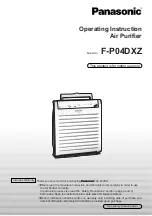
Page 4
•
Air Handling and Fan Coil Units Subzoned with
Therma-Fuser VAV diffusers, Form 6.7.
•
DX Equipment Zoned with Therma-Fuser VAV
diffusers, Form 6.5.
SUPPLY AIR TEMPERATURE
The sources of cooling and heating are controlled from
supply air temperature. As with all VAV systems, the
goals are to achieve a constant supply air temperature
(may be reset to another constant supply air
temperature) and to limit the supply air temperature.
Limits for supply air temperature should be between
50°F/10°C and 68°F/20°C when cooling and between
80°F/26.5°C and 120°F/49°C when heating. The
heating temperature limit should be as low as possible.
These objectives are best achieved by modulating
chilled water valves, hot water valves and other
variable equipment from supply air temperature. On/off
equipment such as DX compressors and electric heat
are cycled from supply air temperature. Use a
discharge air sensor for the supply air temperature
signal.
Mode change between heating, recirculation and
cooling is controlled from room temperature. Signals
from one or more room temperature sensors may be
used for mode change. When using more than one
sensor, either a “majority rules” or a “cooling dominant”
approach is recommended.
STATIC PRESSURE
As with all VAV systems, the fan must run continuously
during occupied times. Goals of static pressure control
are to provide enough static pressure to obtain the
required air volume especially at the diffuser farthest
from the fan, to avoid diffuser noise by limiting static
pressure at both full flow and turndown and to provide
pressure independence or consistent operation as the
system flow changes.
These objectives can be achieved with the usual
methods of automatic static pressure control: bypass
dampers, discharge dampers, zone dampers, and fan
control (variable speed drives, inlet dampers, etc.).
Locate the static pressure sensor as far down the duct
as possible—at least 2/3 down the duct from the first
takeoff.
TROUBLESHOOTING
Trouble shooting Therma-Fuser diffusers requires
looking at the system as a whole. Before examining the
Therma-Fuser diffuser for failure, it is worth the time to
be sure the system is functioning properly and that
something has not been over-looked. Before calling
Acutherm, please complete the data log for all Therma-
Fuser diffusers to be evaluated.
SYSTEM CHECK
The system should be:
1.
Delivering 50° - 68°F / 10° - 20°C supply air wh en
in the cooling mode.
2.
Delivering 80° - 120°F / 26.5° - 49°C supply air
when in the heating mode.
3.
Maintaining static pressure at the inlet to each
Therma-Fuser diffuser between .05 and .25"wg / 12
Pa and 62 Pa.
4.
Maintaining continuous fan operation during
occupied hours.
DIFFUSER CHECK LIST
Once the above checks have been completed, examine
and record the following (Conditions may vary over
time; several measurements at different times may be
required):
1.
Room temperature 4ft / 1.2m above the floor
directly under the Therma-Fuser diffuser.
2.
Supply air temperature at the inlet of the Therma-
Fuser diffuser.
3.
Static pressure at the inlet of the Therma-Fuser
diffuser.
4.
Damper disc opening from the edge of the disc,
measured vertically to the housing. See Fig. 7.
























